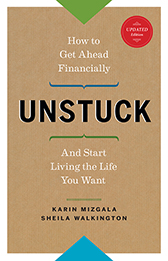By Sheila Walkington, Co-Founder and CFO Money Coaches Canada

The world happiness report was recently released by the United Nations and Canada ranked #7 out of 156 countries. The report rates countries based on income, healthy life expectancy, social support, freedom, trust and generosity, and Canada has consistently placed well since the report began in 2012.
But it would be foolish to think that this report means we have little to worry about as a nation. The truth is, supporting the Canadian way of life, with our strong social safety net, is getting more costly, especially as a huge segment of the population moves into retirement. As a result, Canada has arrived at an economic crossroads. In order to maintain our economic prosperity, we need our economy to grow. But that isn’t going to happen unless we come up with some bold and creative ideas.
How Did We Get Here?
The end of World War II opened up an era of economic growth and optimism in Canada. It was the beginning of the baby boom. Soldiers home from the war were getting married, and Canadians were pursuing the Canadian dream by filling up shiny new suburbs with growing families.
In 1946, William Lyon Mackenzie King was Prime Minister of our young country. It was the year we established a Canadian Citizenship separate from the British and it was also the year Canadian Savings Bonds were introduced. With a tiny population of just over 12 million people, we began creating a standard of living to rival our massive (141.4 million in 1946) neighbour to the South.
 During the baby boom era (1946-64) Canada opened the Trans-Canada highway, built our first subway line in Toronto, entered space with the Alouette I satellite, passed the Canadian Bill of Rights, and established a national healthcare plan. Our population topped 19 million as the baby boom ended in 1964. And as those baby-boomer kids grew up and joined the work force, Canada’s economy took off, and we have enjoyed the spoils ever since.
During the baby boom era (1946-64) Canada opened the Trans-Canada highway, built our first subway line in Toronto, entered space with the Alouette I satellite, passed the Canadian Bill of Rights, and established a national healthcare plan. Our population topped 19 million as the baby boom ended in 1964. And as those baby-boomer kids grew up and joined the work force, Canada’s economy took off, and we have enjoyed the spoils ever since.
But that same generation that served us well, will now have a different impact on our economy. In 2012 1.4 million Canadians were 80 years-old or older, over the next 18 years that number is expected to rise to 3.3 million.
As Canadians exit the workforce, we need to have other Canadians join. Otherwise a slowing economy will mean reduced tax revenues to local, provincial and federal governments, which in turn threatens funding to healthcare, education, CPP, employment insurance and many other social programs we often take for granted. Ideally, we will do more than just maintain the size of our workforce. If we want to ensure the growth of our economy, and protect our social safety net, we need to grow our workforce.
Standing at the Crossroads
So what path leads to the kind of workforce growth we need? The path that recognizes the untapped potential in our country. First, we need to open the world of work to welcome those that have been marginalized for too long; First Nations, visible minorities and those with disabilities. And across all races and demographics, we need to get more women to join the workforce. To do that, we must make child care more affordable and more available. And this is where Canada’s 2018 federal budget let us all down.
A Nod in the Right Direction is Not Enough
The 2018 federal budget tossed the word gender around 358 times, but nothing they have proposed brings us that much closer to gender equality in the workforce.
Introducing pay equity legislation in federally regulated workplaces is a start, but doesn’t address the overall disparity in pay across the private sector. Nor will adding 5 more weeks to parental leave benefits lead to significantly more women going back to work sooner after having a baby.
 What women need, if they are going to fully participate in the workforce; is affordable and accessible child care. The Trudeau government was elected on a promise of high quality, fully-inclusive and affordable child care to all families who need it. But it has yet to deliver on that promise.
What women need, if they are going to fully participate in the workforce; is affordable and accessible child care. The Trudeau government was elected on a promise of high quality, fully-inclusive and affordable child care to all families who need it. But it has yet to deliver on that promise.
Last year’s budget promised the possibility of 40,000 new childcare spaces by 2020. Canadians need hundreds of thousands of affordable childcare spaces, and this latest budget didn’t even speak to the issue.
There was a lot of “woman positive” language in this budget, but Canadian women need far more than words, to make full and equal participation in the workforce a reality. And this isn’t just about making work-life balance better for women. We need women to participate fully in our economy, if we expect to care for our growing senior population, and ensure our own financial safety net, without overburdening the next generation.
Why a National, Subsidized Childcare Program is Vital
Nothing is going to change the fact that it’s women who deal with pregnancy, childbirth and breastfeeding. But we need to change the lingering stigma that this makes them less desirable employees, especially in management positions where men are often still seen as more available to work longer hours and less likely to take time off for child care.
But the challenges of raising children alongside a career go beyond the workplace stigma. The cost of childcare is huge—and so it should be. No parent wants to leave their children in poorly funded facilities managed by frustrated, underpaid caregivers.
But the high cost of care leaves us with frustrating options:
- Some women with a working spouse may choose to stay home simply by personal choice, but others will stay home because quality daycare is not available (child care waiting lists can be quite long), or is simply too expensive (if they will be working just to pay for care, many women opt out, at least until kids are in school). But choosing to stay home often makes it more challenging for women to re-enter the workforce later, and can significantly impact retirement savings and career advancement.
- Women without a working spouse have little or no choice and often have to struggle to make ends meet on what salary remains after childcare expenses.
We need to ensure that the cost and responsibility of child care is more equitably shared by our society. And having children can no longer be a barrier to women fully participating in the workforce. A national, subsidized daycare program would go a long way in doing that.
 We’re All in This Together
We’re All in This Together
Women have the right to fully, and fairly, participate in the economy for personal and financial reasons. But all Canadians must recognize the importance of working women to our country’s long term economic growth and prosperity.
Let your politicians know that they need to do better.
As a woman, it’s also important to create a financial plan that allows you to make decisions about your work life that are in keeping with your goals and values. A money coach recognizes that financial well-being goes far beyond dollars and cents and supports all facets of your life, now and as your life changes.


